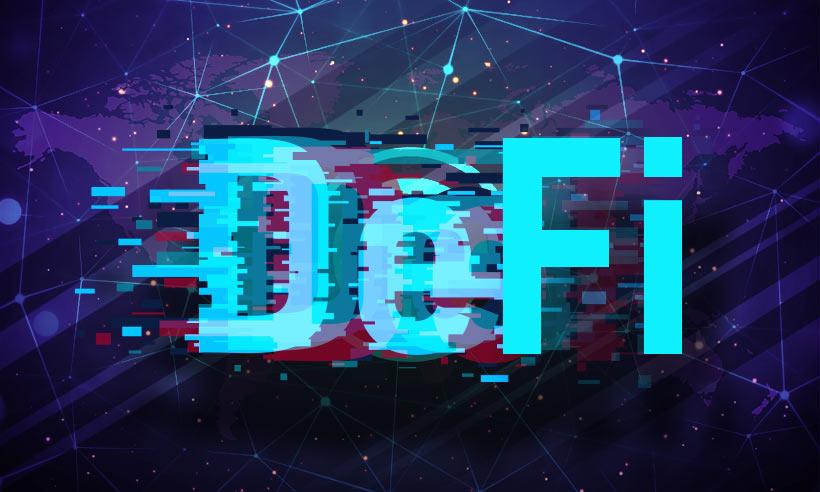What Is DeFi (Decentralized Finance)?
Table of contents
DeFi technology generates decentralised money and does away with the need for central banks under the power of the government to produce and manage the currency. But DeFi technology can also offer a wide range of additional blockchain-based financial services applications. DeFi technology is used by fintech businesses to provide insurance, stock trading, savings accounts, and loans, among other services.
How Does DeFi Work?
The blockchain technology that cryptocurrencies employ is used in decentralised finance. A distributed and secure database or ledger is referred to as a blockchain. The blockchain is operated and transactions are handled by programmes known as dApps.
The blockchain records transactions as blocks that are later confirmed by other users. If all of these verifiers concur on a transaction, the block is closed and encrypted, and a new block is made with details of the old block inside of it.
The term "blockchain" refers to how the blocks are "chained" together by the data in each succeeding block. There is no way to edit a blockchain since changes to the information in earlier blocks always have an impact on later blocks. This idea, coupled with other security measures, gives a blockchain its security.
Key Difference Between DeFi And CeFi
Even though both centralised finance and decentralised finance strive to extend the use of blockchain globally, there are some fundamental differences between the two. Let's look into these discrepancies.
Public verification
Even if DeFi code may not always be available online, its execution must be open to public inspection to qualify as a non-custodial DeFi. This means that, in contrast to CeFI, any DeFi user can watch the execution of DeFi state changes and later confirm it.
Atomicity
A blockchain transaction makes it possible to carry out successive tasks. It is possible to make these operations atomic, which means that they will either succeed all at once or fail. CeFi does not have this configurable atomicity component.
Anonymous development
Users who utilise centralised finance have less anonymity than those who use decentralised finance. Most DeFi projects are managed by unnamed teams of people.
Custody
DeFi gives its customers total control over their assets, in contrast to CeFi. The difficulty with this is that users must deal with all the technical risks. CeFi is more advantageous in this situation. As custodians, the centralised financial platforms are a well-liked option for handling cryptocurrency holdings.
Transaction cost
Transaction fees are frequently charged in DeFi. The institutions in CeFi, on the other hand, provide transactions at no additional cost because CeFi conducts stringent KYC and AML checks.
Cross-chain services
Most cryptocurrencies are regularly traded on centralised financial platforms. These tokens are often not supported by decentralised finance since they are complicated and slow down the cross-chain exchange.
Fiat conversion flexibility
It is simpler for customers to trade on a CeFi platform than a DeFi platform because CeFi operates on a fiat currency exchange paradigm.
Advantages of DeFi
No chance of Human Errors
Most procedures in the conventional financial system require human involvement to complete, which raises the possibility that occasional errors will be made. The DeFi technology ensures that there is no need for human involvement, and the automated service system of each of the networks performs significantly better.
Permissionless Operations
It takes time since one must obtain authorization from an intermediary for practically every transaction included in a TradFi system. Without requesting permission, one can interact with financial services in DeFi. The peer-to-peer connection and agility draw additional people.
Lending
One can obtain a loan using their cold wallets in the crypto community, particularly in those that are part of a DeFi chain. Both sides benefit from this possibility, which gives the borrower the ability to receive interest payments and the lender's access to cash.
Decentralized Exchanges
One can use the proof-of-stake blockchain network found in a DeFi system to secure their important assets in a more secure environment. This network allows users to be rewarded for securing and validating a blockchain network's transactions.
No-Loss Games and Lotteries
A DeFi system's smart contracts can allow users to participate in a lottery that has no losses through various procedures. Everyone who participated will receive their money back, and as there are no middlemen involved, only one lucky winner will walk away with all the proceeds.
Disadvantages of DeFi
Scalability
In this system as well as all blockchain systems, it is the largest issue. The system is in doubt since the network is not expanding as quickly as the transaction rates are, and the agility is deteriorating day by day as a result.
Uncertainty
This issue generally occurs in networks that are constantly running with updates. The bitcoin market is constantly uncertain, and many of its network infrastructures are going through significant changes. For instance, Ethereum is switching from PoW to PoS, which will undoubtedly result in additional problems.
Liquidity
We are contrasting the DeFi chain with the entire financial system. By the tenth month of 2020, DeFi only has investments worth 12.5 billion dollars. When compared to the TradFi system, this is a drop in the bucket.
Lack of Insurance
A DeFi chain's failure to offer investors a streamlined insurance protocol is another drawback. Because of this major issue and lack of authority and accountability, many people have lost faith in the system.
Low Interoperability
DeFi still has to undergo a lot of modifications and improvements. The chain that many systems, including Bitcoin, Ethereum, and BSC, employ is not compatible enough to support all of the apps, processes, and protocols at once and connect them all. The system management procedure might be rather frantic as a result.
How to Invest in Decentralized Finance?
DeFi investments can be made in a variety of ways. The easiest way, which just exposes you to how to invest in defi in general, is to purchase Ether or another coin that makes use of DeFi. Purchasing a coin with DeFi power gives you exposure to almost the entire DeFi market.
To earn income on your holdings, you can deposit cryptocurrencies with a DeFi lending facility directly. If you are willing to deposit money for a longer period, you can obtain greater interest rates. The interest rate you receive on your deposit may be either fixed or variable and subject to market fluctuations.
Since there is a significant demand for deposits across the several DeFi platforms, a business known as "yield farming" has developed. Yield farmers regularly track the current interest rates and incentives provided by other platforms and deposit money on whichever platform offers the highest interest rate or other incentives. The yield farmers optimise their income by shifting their deposits to the alternative platform if it starts to offer a better incentive. Yield farmers continue to migrate their money from platform to platform as incentives are continuously changing.
You can purchase a token like Uniswap's UNI if you want a say in the direction that DeFi protocols go going forward. As a governance token, UNI offers you voting power over the direction of the Uniswap protocol in proportion to your ownership. The future of the service attracts more interest from users as a result of their participation in the decision-making process, and larger holdings of UNI are needed to maintain significant decision-making ability. The token's price may rise sharply as a result of this dynamic.
5 Best DeFi Projects In 2022
1. PancakeSwap
Pancake Swap is a decentralised exchange (DEX) project based on the BNB chain that enables users to swap BEP-20 tokens quickly and affordably. Given its token value, it has shown strong growth and is unquestionably an excellent investment. The project, incidentally, has a native coin called the CAKE token.
2. UniSwap
One of the top Ethereum blockchain-based decentralised exchanges is called Uniswap (UNI). The UNI token, a native token of the project, is also available. Due to its rigorous user privacy policies, Uniswap is a pretty well-liked DeFi initiative among investors globally. It is renowned for its adaptable approach to system upgrades based on the demands of investors.
3. Metaple
A decentralised financial (DeFi) solution called Metaple allows users to generate their crypto assets through farming, trading, staking, and play-to-earn games. With the use of peer-to-peer (P2P) decentralised applications (DApps), users of Metaple Finance's services can interact with this ecosystem and fully control their assets while using the AMM technique.
4. panKUKU
With panKUKU being the largest DEX project available, you won't need to waste time looking for DeFi platforms, coins, goods, and services elsewhere. The project contains a powerful NFT marketplace called KUKU Shop, a fully featured exchange, and its native coin called KUKU token.
5. Sushiswap
Sushiswap, which debuted in August 2020, is yet another well-liked DeFi initiative that offers a decentralised, community-driven platform for trading, earning, stacking, lending, and borrowing cryptocurrencies. A decentralised exchange (DEX) called Sushi Swap operates on the idea of an automated market maker (AMM). Users can trade cryptocurrency tokens, but no central body oversees the transactions.
What Is The Future Of DeFi?
It is undeniable that the introduction of DeFi is pushing the financial sector into unknown waters. DeFi startups are growing and will influence the direction of finance. The overall impact of decentralised finance cannot yet be predicted, although early indications have shown both its benefits and drawbacks.
Optimism Abound For DeFi
The closed-door model used by traditional banking and financial services has been cracked open by DeFi. Smart contracts are used in their place, which lowers the cost of services for users and eliminates the need for intermediaries. New markets have been opened up as a result of the sudden appearance of DeFi apps, including stablecoins, central exchanges, and lending instruments.
Whether they choose to or not, banks, insurers, investment companies, and mortgage lenders cannot ignore DeFi's rapid expansion. Neglecting the modern blockchain financing environment would be foolish and could result in market share loss. Many financial facilities will eventually switch to DeFi networks, according to cryptocurrency specialists.
Pitfalls Of DeFi
DeFi development is being discussed with excitement, but the smart-contract blockchain ecosystem is still in its infancy. The use of pseudonyms in DeFi's transactions raises fears that it may facilitate money laundering and other illegal activities. Financial regulators have not yet taken the necessary steps to resolve any potential problems that could result from the use of DeFi.
Due to the volatility of cryptocurrencies, there is a built-in danger of financial loss while taking part in yield-generating schemes in the DeFi market. Given that each DeFi app has a distinct business plan, investors need to be aware of the risk exposure associated with the cryptocurrency market. The complexity of tax submission may increase due to inconsistent regulations.
Conclusion
You must arrange your fintech product strategically given DeFi's enormous popularity. Consider the advantages and disadvantages of decentralised finance, as well as how you may profit from its explosive development. As you consider the idea of a borderless counterpart, weigh the potential regulatory risks, the hunger of investors, and potential partnerships with the conventional finance industry.

